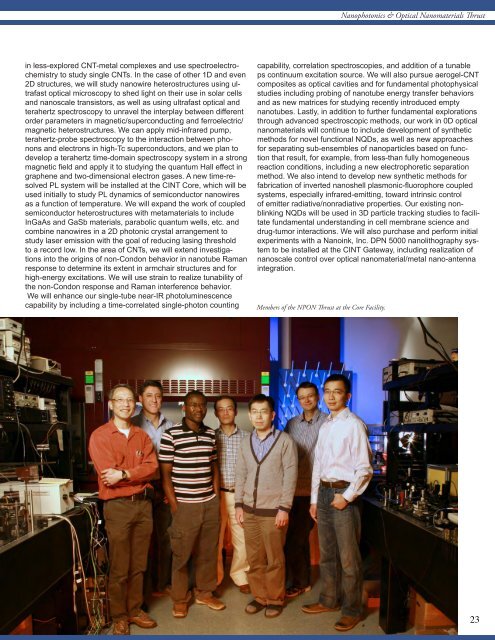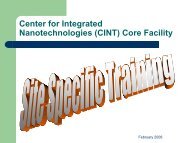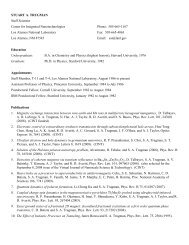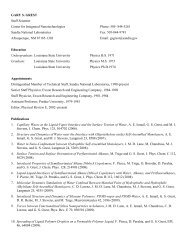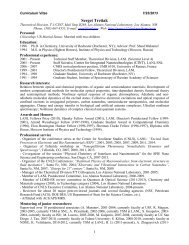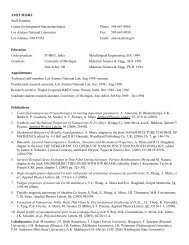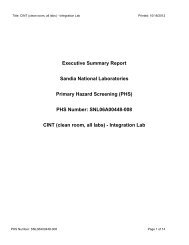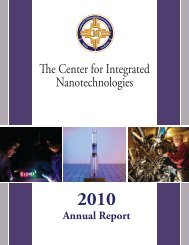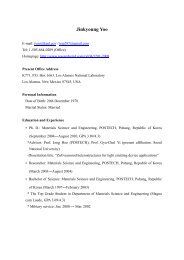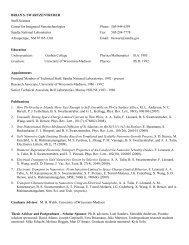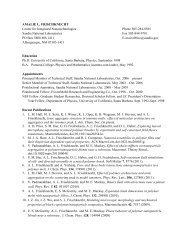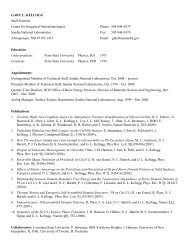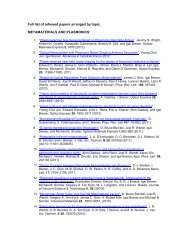2011 Annual Report - Center for Integrated Nanotechnologies - Los ...
2011 Annual Report - Center for Integrated Nanotechnologies - Los ...
2011 Annual Report - Center for Integrated Nanotechnologies - Los ...
Create successful ePaper yourself
Turn your PDF publications into a flip-book with our unique Google optimized e-Paper software.
Nanophotonics & Optical Nanomaterials Thrust<br />
in less-explored CNT-metal complexes and use spectroelectrochemistry<br />
to study single CNTs. In the case of other 1D and even<br />
2D structures, we will study nanowire heterostructures using ultrafast<br />
optical microscopy to shed light on their use in solar cells<br />
and nanoscale transistors, as well as using ultrafast optical and<br />
terahertz spectroscopy to unravel the interplay between different<br />
order parameters in magnetic/superconducting and ferroelectric/<br />
magnetic heterostructures. We can apply mid-infrared pump,<br />
terahertz-probe spectroscopy to the interaction between phonons<br />
and electrons in high-Tc superconductors, and we plan to<br />
develop a terahertz time-domain spectroscopy system in a strong<br />
magnetic field and apply it to studying the quantum Hall effect in<br />
graphene and two-dimensional electron gases. A new time-resolved<br />
PL system will be installed at the CINT Core, which will be<br />
used initially to study PL dynamics of semiconductor nanowires<br />
as a function of temperature. We will expand the work of coupled<br />
semiconductor heterostructures with metamaterials to include<br />
InGaAs and GaSb materials, parabolic quantum wells, etc. and<br />
combine nanowires in a 2D photonic crystal arrangement to<br />
study laser emission with the goal of reducing lasing threshold<br />
to a record low. In the area of CNTs, we will extend investigations<br />
into the origins of non-Condon behavior in nanotube Raman<br />
response to determine its extent in armchair structures and <strong>for</strong><br />
high-energy excitations. We will use strain to realize tunability of<br />
the non-Condon response and Raman interference behavior.<br />
We will enhance our single-tube near-IR photoluminescence<br />
capability by including a time-correlated single-photon counting<br />
capability, correlation spectroscopies, and addition of a tunable<br />
ps continuum excitation source. We will also pursue aerogel-CNT<br />
composites as optical cavities and <strong>for</strong> fundamental photophysical<br />
studies including probing of nanotube energy transfer behaviors<br />
and as new matrices <strong>for</strong> studying recently introduced empty<br />
nanotubes. Lastly, in addition to further fundamental explorations<br />
through advanced spectroscopic methods, our work in 0D optical<br />
nanomaterials will continue to include development of synthetic<br />
methods <strong>for</strong> novel functional NQDs, as well as new approaches<br />
<strong>for</strong> separating sub-ensembles of nanoparticles based on function<br />
that result, <strong>for</strong> example, from less-than fully homogeneous<br />
reaction conditions, including a new electrophoretic separation<br />
method. We also intend to develop new synthetic methods <strong>for</strong><br />
fabrication of inverted nanoshell plasmonic-fluorophore coupled<br />
systems, especially infrared-emitting, toward intrinsic control<br />
of emitter radiative/nonradiative properties. Our existing nonblinking<br />
NQDs will be used in 3D particle tracking studies to facilitate<br />
fundamental understanding in cell membrane science and<br />
drug-tumor interactions. We will also purchase and per<strong>for</strong>m initial<br />
experiments with a Nanoink, Inc. DPN 5000 nanolithography system<br />
to be installed at the CINT Gateway, including realization of<br />
nanoscale control over optical nanomaterial/metal nano-antenna<br />
integration.<br />
Members of the NPON Thrust at the Core Facility.<br />
23


